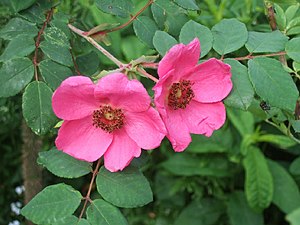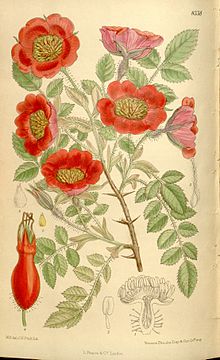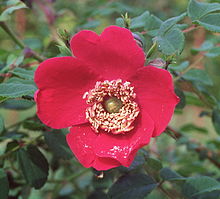Mandarin rose
| Mandarin rose | ||||||||||||
|---|---|---|---|---|---|---|---|---|---|---|---|---|

Mandarin rose ( Rosa moyesii ) |
||||||||||||
| Systematics | ||||||||||||
|
||||||||||||
| Scientific name | ||||||||||||
| Rosa moyesii | ||||||||||||
| Hemsl. & EHWilson |
The Mandarin Rose ( Rosa moyesii ), also blood-Rose or Red Rose clump called, is a plant of the genus roses ( Rosa ) within the family of the rose family (Rosaceae). It is of course common in China.
description
Appearance and leaf
Rosa moyesii grows as a shrub that reaches heights of about 1 to 4 meters. The stem-round branches have a sparsely short, downy hairy to bald bark . They are seldom reinforced. If there are spines , then they stand in pairs under the leaves and are straight or slightly curved, up to 5 millimeters long, stocky, flat and widen to a broad base at the bottom.
The alternate leaves arranged on the branches are divided into petioles and leaf blades and a total of 7 to 13 centimeters long. The leaf stalk and the leaf rhachis are short hairy, glandular-hairy and sparsely short thorns. The imparipinnate leaf blade has 7 to 13 leaflets . The leaflets are egg-shaped, elliptical or oblong-egg-shaped with a length of 1 to 5 centimeters and a width of 0.8 to 2.5 centimeters with a slightly rounded to broadly wedge-shaped base and a pointed or rounded-blunt upper end. The leaf margins are pointed and serrated. The underside of the leaf is dense or hairy only along the raised leaf veins and glabrous on the upper side. The relatively wide stipules are fused with the petiole for most of their length. The free area of the stipules is glabrous, long-ovate with a pointed upper end and a glandular serrate edge.
Inflorescence, flower and fruit
The flowering period in China extends from June to July. The flowers stand alone or in twos or threes in bunches. The 1 to 3 centimeter long peduncle is usually hairy with a dense stalk or glandular or rarely bald. The one or two bracts are elongated-ovate with a length of up to 2 centimeters with a pointed or pointed upper end and a glandular-downy hairy edge.
The fragrant, hermaphrodite blooms are radial symmetry with a diameter of 4 to 6 centimeters and five-fold with a double inflorescence . The flower cup (hypanthium) is egg-shaped. The five leaf-like, pinnate-lobed sepals are egg-shaped in outline, glabrous on the underside or with a few glandular scales at their base and hairy on top. The five free, dark red petals are broadly obovate with a broad, wedge-shaped base and an edged upper end. The many stamens have yellow anthers. The free, downy hairy styles are shorter than the stamens.
In autumn , in China between August and October, the numerous rose hips ripen and turn orange-red or purple-red. The stalked-glandular hairy rose hips are up to 5 centimeters long and 1 to 2 centimeters in diameter, bottle-shaped or spherical-egg-shaped with a short beak at the top. The rose hips are crowned by the durable, upright sepals.
Occurrence
Rosa moyesii thrives in bushes and on slopes at altitudes of 2700 to 3800 meters in the Chinese provinces of Shaanxi , Sichuan and Yunnan .
Systematics
The first description of Rosa moyesii was made in 1906 by William Hemsley and Ernest Henry Wilson in the Bulletin of Miscellaneous Information Kew , 1906, 5, pp 159-160. The specific epithet moyesii honors the host of the plant collector Ernest Henry Wilson, the British missionary Reverend J. Moyes . The type material was collected in Sichuan on the Tibetan border near Tatien-lu at an altitude of 2700 to 4000 meters and deposited with the collection number Pratt 172 in the herbarium of the Royal Botanic Gardens, it is also listed under Wilson 3543.
From Rosa moyesii there are two varieties:
- Rosa moyesii Hemsl. & EHWilson var. Moyesii
- Rosa moyesii var. Pubescens T.T.Yü & HTTsai : It only occurs in Sichuan.
Use as an ornamental plant
The single-blooming wild rose Rosa moyesii is very hardy and also tolerates partial shade. Some varieties and hybrids are used as ornamental plants in the temperate areas in parks and gardens.
There are some intersections (hybrids) of Rosa moyesii with garden roses .
Varieties (selection):
- 'Nevada' Dot 1927, creamy white - is the best known hybrid
- 'Marguerite Hilling', 1959, pink sport from 'Nevada'
- 'Highdownensis', 1928, carmine
- 'Eos', 1959, red with a light center
- 'Eddie´s Crimson' 1956, fire red
- 'Eddie's Jewel' 1962
- The sport with the cultivar name 'Geranium' (origin unknown, 1938) has scarlet-pink flowers
gallery
Rosa moyesii hybrids:
swell
- Gu Cuizhi & Kenneth R. Robertson: Rosa : Rosa moyesii , p. 363 - the same text online as the printed work , In: Wu Zheng-yi & Peter H. Raven (Eds.): Flora of China , Volume 9 - Pittosporaceae through Connaraceae , Science Press and Missouri Botanical Garden Press, Beijing and St. Louis, 2003. ISBN 1-930723-14-8 (Sections Description, Occurrence and Systematics)
Individual evidence
- ^ A b c Rosa moyesii in the Germplasm Resources Information Network (GRIN), USDA , ARS , National Genetic Resources Program. National Germplasm Resources Laboratory, Beltsville, Maryland. Retrieved September 4, 2014.
- ↑ a b c Gordon Cheers (Ed.): Botanica. The ABC of plants. 10,000 species in text and images . Könemann Verlagsgesellschaft, 2003, ISBN 3-8331-1600-5 (therein page 774).
- ↑ a b c d e f Gu Cuizhi & Kenneth R. Robertson: Rosa : Rosa moyesii , p. 363 - the same text online as the printed work , In: Wu Zheng-yi & Peter H. Raven (eds.): Flora of China , Volume 9 - Pittosporaceae through Connaraceae , Science Press and Missouri Botanical Garden Press, Beijing and St. Louis, 2003. ISBN 1-930723-14-8
- ↑ Mandarin Rose at Tropicos.org. Missouri Botanical Garden, St. Louis, accessed September 4, 2014.








